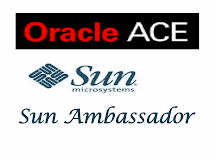Steps for setting up Oracle Fusion Middleware
1. Join the Oracle Technology Network (OTN) if not already a member. After going to OTN.oracle.com, on the top right part of the screen there is a signin window. If not already a member you need to join (it's free). OTN is your primary Oracle resource for software downloads, whitepapers, forums, documentation as an Oracle developer. OTN will contain downloads for all software installs for this environment.
2. Install Oracle JDeveloper 11g. JDeveloper is an enterprise Integrated Development Environment (IDE) that contains all the user interfaces and components for different types of middleware applications and components. Click the license agreement and install JDeveloper for the platform you are using. Although I'm a Mac user, I'm using the Windows version due to the larger install base. Go to the download directory for the platform you are running and run the software you downloaded. If you go with the default and complete install, some of the key feature can be seen in the list below. This list highlights the amount of functionality in JDeveloper.
* Oracle JDeveloper (Integrated Development Environment)
* Oracle ADF (Application Development Framework)
* Oracle WebLogic Server (Application Server)
* JDK 6 (Windows and Linux)
* Oracle SOA Suite
* Oracle WebCenter
* UML Development
* XML Development
* Database Development
* Web Services Development
* Oracle Toplink Development
* ADF Faces and Business Components
* Oracle Toplink Development
* Java EE Application Server Integration and Deployment
3. Install an Oracle database server. I'd recommend a version of Oracle Database Server 11g or the Express Edition. If you have DBA experience and can set up a loopback adapter I'd set up the Oracle Database Server 11g. If a developer and don't want to mess with managing a database server, l then I'd highly recommend installing the Oracle Database 10g Express Edition. This is a pretty simple point and click database environment. Go to OTN and install the database version you'd prefer to work with (installation instructions can be found on OTN). Go to the JDeveloper New Menu and choose database connection and you're on your way.
You now have a nice environment for developing Oracle Fusion Middleware components or applications.
- Oracle JDeveloper
- Oracle Weblogic Application Server
- Oracle Database Server
Two great sources for getting started include:
- JDeveloper and Oracle Fusion Middleware documentation available on OTN.
- Online demos, tutorials and code samples available in the Help Menu of JDeveloper.

